Towards Zero Carbon - Catalytic Architectures
Towards Zero Carbon
Our research will support New Zealand’s goal for ‘net zero’ carbon emissions by 2050 by exploring new materials that will:
- Catch CO₂ from air and waste streams, through clever chemistry that attracts CO₂ to the surfaces of 3D spongelike materials (such as metal-organic frameworks, or MOFs);
- Decarbonise the energy sector by designing new catalysts that will transform captured CO₂ into green fuels using renewable energy inputs. These new fuels (including hydrogen) will replace carbon-based fuels and remove carbon from energy systems.
Our research will support New Zealand’s goal for ‘net zero’ carbon emissions by 2050 by exploring new materials that will catch CO₂ and decarbonise the energy sector.
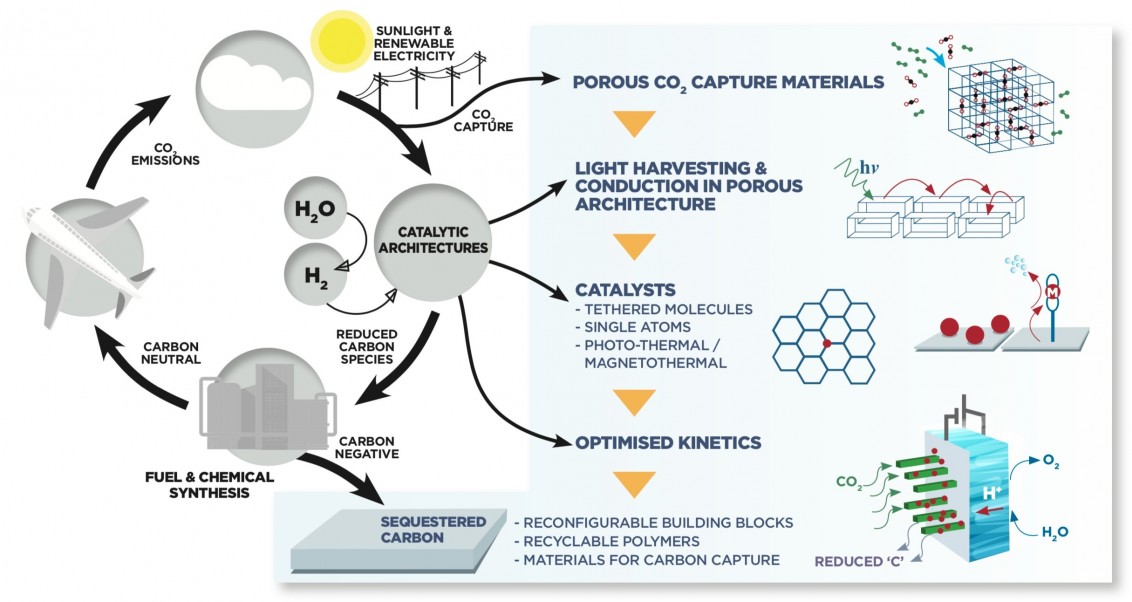
Our vision of carbon negative and carbon neutral cycles underpinned by catalytic architectures.
CA Project 1: Capture CO₂ using porous materials
Project Leader:
Lead Principal Investigators:
Metal-organic frameworks (MOFs) are three dimensional porous materials with exceptionally large surface areas and huge potential for use in CO₂ capture, separation, storage and conversion. We’ll investigate new MOFs for their ability to adsorb gases of interest, especially carbon dioxide (using synthetic chemistry and X-Ray diffraction). We will work on improving the MOFs’ gas-binding capacity, speed and specificity, as well as stability over repetitive cycling. We’ll also look at the underlying mechanisms governing the properties and behaviours of nanoscale MOFs (nMOFs). We’ll design and develop stable nMOFs, using new colloidal-based techniques to study nanocrystal formation, growth and structure.
CA Project 2: Make catalysts for CO₂ reduction
Project Leader:
Lead Principal Investigators:
Sally Brooker, Nigel Lucas, Anna Garden.
We’ll develop new molecular catalysts for CO₂ reduction, focusing on single-atom reaction sites and incorporating these new molecular catalysts within porous frameworks. We’ll design new polydentate ligand complexes with optimal electrocatalytic CO₂ reduction ability (a key potential step in carbon capture and use). We’ll also use computational modelling of copper nanocatalysts to find unique nanoparticle structures, using in-house global optimisation algorithms together with established electronic structure codes.
CA Project 3: Develop thermal CO₂ reduction
Project Leader:
Lead Principal Investigators:
Geoff Waterhouse, Chris Bumby, John Kennedy.
Catalytic CO₂ conversion is an emerging technology with potential to ease the environmental effects of greenhouse gas emissions while simultaneously producing higher value chemical feedstocks. Industrial CO₂ hydrogenation processes, despite being well established and selective towards longer chain hydrocarbons, are thermal catalytic processes requiring high temperature and pressure conditions. We will focus on the development of photothermal and photocatalytic materials for CO₂ hydrogenation – materials which are capable of effectively harnessing the vast amounts of solar energy interacting with the Earth’s surface, for chemical conversion processes. We aim to make high-value light alkanes and olefins. Plus, we’ll make and assess catalytic processes, translate the best catalytic materials into nano-catalytic architectures, and then evaluate the performance of these new materials (using novel CO₂ hydrogenation reactors).
CA Project 4: Exploit kinetics and transport in catalytic architectures
Project Leader:
Lead Principal Investigators:
Justin Hodgkiss, Keith Gordon, Aaron Marshall.
We’ll disentangle kinetic and mass transport effects on the CO₂ reduction reaction at model porous electrode structures in order to better understand and suggest new materials and structures to make. We’ll be looking at the way light and electricity is delivered to catalytic sites within porous frameworks. We will explore structure-function relationships by measuring exciton and charge diffusion coefficients, using ultrafast optical spectroscopy. Plus, we’ll examine catalytic turnover and degradation by measuring the spectra of short-lived species (i.e., exist for nanoseconds) and characterising these using Raman and computational methods - and also observe the changes in phone modes via low frequency Raman.
PhD Scholarships available in Catalytic Architectures
See here for the full list of PhD Scholarships available in Catalytic Architectures funded by the MacDiarmid Institute and how to apply.
In the news
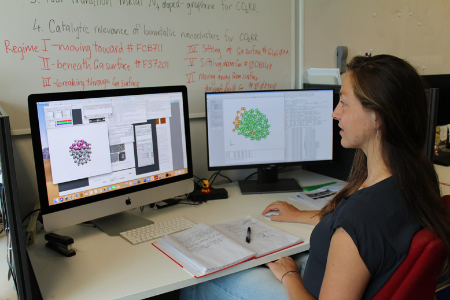
News Article
Liquid metals that create nanostructure - it’s the little details that count
March 8, 2021
PhD candidate and MacDiarmid Institute researcher Stephanie Lambie from successfully kick-started a new collaboration with FLEET.
Read more about Liquid metals that create nanostructure - it’s the little details that count

News Article
MacDiarmid Institute researchers win NZ Institute Chemistry awards
September 15, 2020
There were outstanding results announced for the Institute’s researchers in the 2020 New Zealand Institute of Chemistry (NZIC) awards.
Read more about MacDiarmid Institute researchers win NZ Institute Chemistry awards
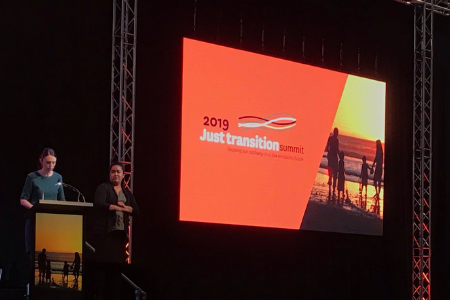
Annual Report
Materials science in the new energy sector
June 11, 2020
In May, the Government hosted the Just Transition summit in Taranaki on preparing for a low emissions economy,
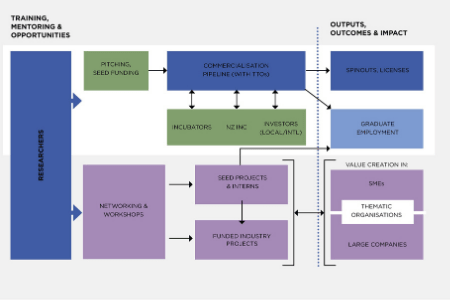
Annual Report
An integrated research commercialisation approach
June 11, 2020
Our efforts towards supporting emerging science entrepreneurs links students, experienced researchers, industry and investors across the country.
Read more about An integrated research commercialisation approach
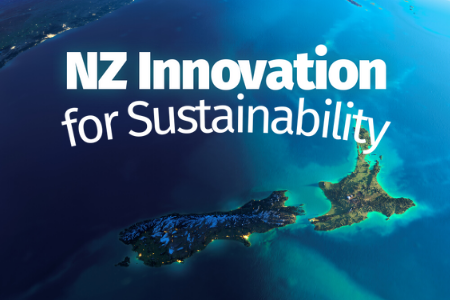
Annual Report
How can materials science offer a greener future for our planet? - Annual Report 2019
May 28, 2020
In 2019, we focused our annual regional showcase on 'NZ Innovation for Sustainability.'
Videos
April 8, 2019
Oxford Professor Henry Snaith and MacDiarmid Institute Co-Director Professor Justin Hodgkiss discuss the economics and science behind the remarkable growth in photovoltaics and reflect on some of the benefits of solar energy capture during the 8th International Conference on Advanced Materials and Nanotechnology (AMN8).
Nature of Science - Maan Alkaisi
March 21, 2019
The MacDiarmid Institute's Professor Maan Alkaisi speaks about his interesting work in nanotechnology - what is nanotechology and how do we use it?
His work is focussed on nanoscale structures and devices and is interested in how properties behave differently at small scales. From a young age Maan has been fascinated by the capability of small devices, like transistors and digital cameras, and his work is focused how making small, better, and more effective electronic devices to help us live healthier and better lives.
MacDiarmid Institute alumna Dr Rebecca Hawke: researching new solar cells
February 25, 2019
Physicist and MacDiarmid Institute alumna Dr Rebecca Hawke talks about solar cells and where science has taken her around the world.
This video includes captions.
1. Where in the world would you study science?
2. What are 5 items you can see around you that materials scientists worked on?
Read more MacDiarmid Institute alumna Dr Rebecca Hawke: researching new solar cells
MacDiarmid Institute alumnus Dr Matthew Cowan: the importance of failure in success
February 25, 2019
MacDiarmid Institute alumnus Dr Matthew Cowan discusses his research and the importance of failure in success.
This video includes captions.
Read more MacDiarmid Institute alumnus Dr Matthew Cowan: the importance of failure in success
2015 Lecture Series: The Energy Revolution
February 16, 2019
The age of fossil fuels is coming to an end. Global warming from their burning is undeniable, but when will tomorrow begin? Will it be a smooth transition into renewable energy? Is there even enough sunlight striking the Earth to supply the increasing energy demands of 6-9 billion humans? Can our renewable energy sources be enough for a nuclear-averse country like New Zealand?
In the 2015 MacDiarmid Institute Regional Lecture Series: The Energy Revolution MacDiarmid Institute researchers Justin Hodgkiss and Luke Liu discuss and begin to answer these big questions.


